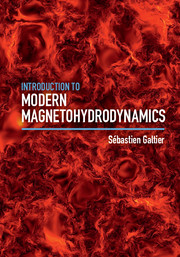Preface
Published online by Cambridge University Press: 13 October 2016
Summary
Physical laws should have
mathematical beauty
P. A. M. Dirac – Nobel Prize in Physics (1933)
In our familiar environment, matter appears in solid, liquid, or gaseous form. This triptych vision of the world was shaken in the twentieth century when astronomers revealed that most of the extraterrestrial matter – namely more than 99% of the ordinary matter in the Universe – is actually in an ionized state called plasma whose physical properties differ fundamentally from those of a neutral gas. The study of this fourth state of matter was developed mainly in the second half of the twentieth century and is now considered a major branch of modern physics. A decisive step was taken in 1942 when the Swedish astrophysicist Hannes Alfvén (1908–1995) proposed the theory of magnetohydrodynamics (MHD) by connecting the Maxwell electrodynamics with the Navier–Stokes hydrodynamics. In this framework, plasmas are described macroscopically as a fluid and the corpuscular aspect of ions and electrons is ignored. Nowadays, MHD has emerged as the central theory to understand the machinery of the Sun, stars, stellar winds, accretion disks around super-massive objects such as black holes with the formation of extragalactic jets, interstellar clouds, and planetary magnetospheres. Also, when H. Alfvén was awarded the Nobel Prize in Physics in 1970, the Committee congratulated him “for fundamental work and discoveries in magnetohydrodynamics with fruitful applications in different parts of plasma physics.”
The MHD description is not limited to astrophysical plasmas, but is also widely used in the framework of laboratory experiments or industrial developments for which plasmas and conducting liquid metals are used. In the first case, the emblematic example is certainly controlled nuclear fusion with the International Thermonuclear Experimental Reactor (ITER) in Cadarache. Indeed, the control of a magnetically confined plasma requires an understanding of the large-scale equilibrium and the solution of stability problems whose theoretical framework is basically MHD. Liquid metals are also used, for example, in experiments to investigate the mechanism of magnetic field generation – the dynamo effect – that occurs naturally in the liquid outer core of our planet via turbulent motions of a mixture of liquid metals. Most of the natural MHD flows cited above are far from thermodynamic equilibrium, with highly turbulent dynamics.
Information
- Type
- Chapter
- Information
- Introduction to Modern Magnetohydrodynamics , pp. xiii - xivPublisher: Cambridge University PressPrint publication year: 2016
